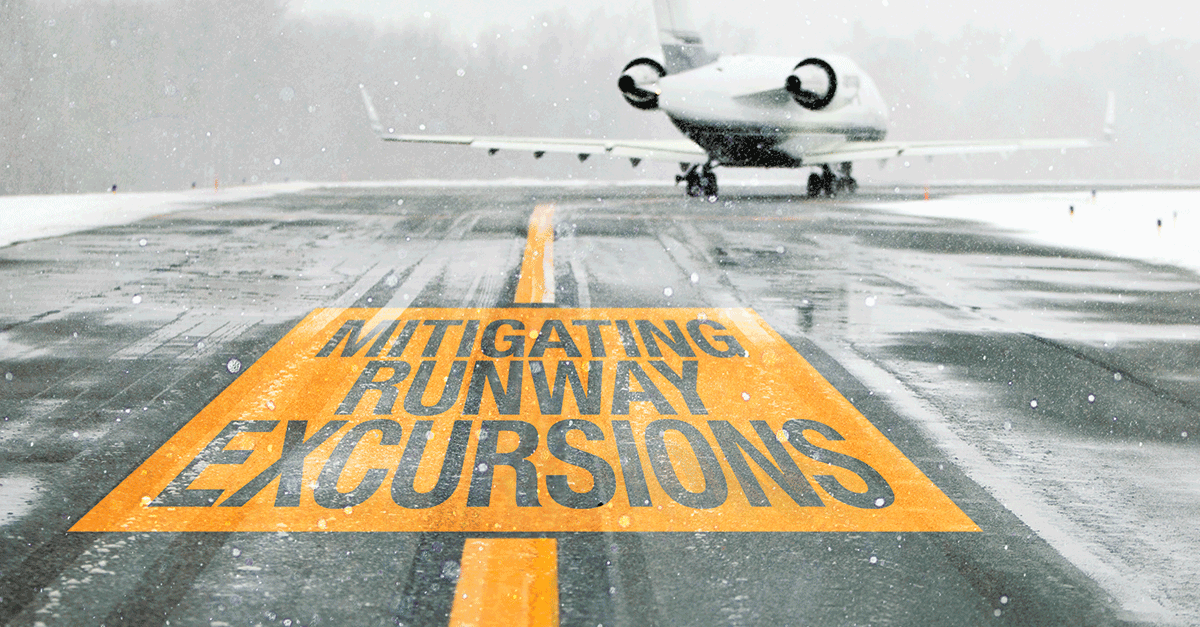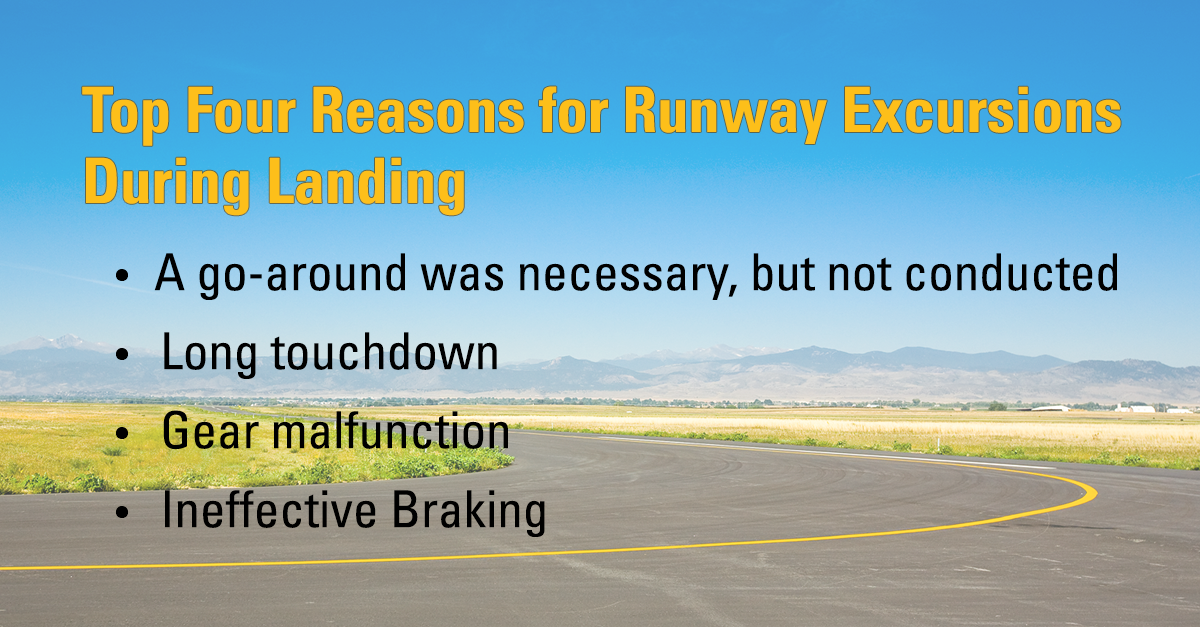
Understanding why runway excursions occur can help prevent accidents.
May 23, 2016
On August 30, 2002, N45CP, a Learjet 25 being operated on a Part 135 air ambulance flight, overran Runway 04 at Blue Grass Airport (LEX) in Lexington, KY. One passenger was fatally injured. The captain, first officer, flight nurse and another passenger were seriously injured, and a truck driver received minor injuries. The NTSB determined the probable cause to be the captain’s addition of forward thrust during the landing rollout, which resulted in lack of braking effectiveness and subsequent runway overrun.
Defining the Problem
According to the International Civil Aviation Organization (ICAO), a runway excursion is defined as “a veer-off or overrun of the runway surface.” This type of departure of an aircraft from either the side or end of a runway can occur during the takeoff or landing and can be intentional or not.
Runway excursions, including runway overruns like the one that occurred at LEX in 2002, are one of the most common causes of aircraft accidents. A Flight Safety Foundation study titled “Reducing the Risk of Runway Excursions” found 30 percent of accidents from 1995 to 2008 were related to runways. Of those, 97 percent involved excursions, resulting in about 30 runway excursions a year. Some 70 percent of those accidents occurred during the landing phase.
While most runway excursion accidents are survivable, runway excursion events account for a large number of fatalities due to their high rate of occurrence. Another report indicates runway excursions cost the global aviation industry about $900 million annually.
Each year the NBAA Safety Committee holds a risk-assessment meeting, using a data-driven approach to set safety goals and priorities for the coming year. The committee consistently finds runway excursions to be a problem area. In the 2016 survey, which collected feedback from more than 800 business aviation professionals, 35 percent of responders indicated the risk of a runway excursion was a significant concern for them and their flight department.
“Although the industry has been talking about runway excursions and examining hazards and risk-mitigation efforts for several years, the prevalence of runway excursion events is still alarmingly high,” said Peter Korns, NBAA’s manager of operations.
However, with proper planning – and when aircraft performance considerations are taken into account and crews have runway condition awareness and adhere to approach and landing best practices – these accidents are highly preventable.
Determining Excursion Precursors
Why do runway excursions continue to occur with such frequency? What are the precursors or hazards that lead to these events? The answers to these questions lie in several factors.
The Flight Safety Foundation study found the top four reasons for runway excursions during landing to be:
- A go-around was necessary but not conducted
- Long touchdown
- Gear malfunction
- Ineffective braking (due to hydroplaning, runway contamination, improper technique, etc.)
The study also noted that multiple risk factors in the same scenario do not result in a linear increase of risk. Instead, combining risk factors has a synergistic effect.
Convenience can also create a significant runway excursion hazard. In some cases, a pilot might try to land on a section of the runway that makes a particular turn-off more convenient, perhaps to reach a preferred FBO or parking area with minimal taxi time. The desire for more efficient taxiing must be weighed against the risks of a short or long touchdown.
Another likely cause of excursions – though difficult to quantify – is pilot attitude or overconfidence. Data indicates pilots are less likely to land long or carry extra speed on shorter runways. They tend to be more focused on making a precise landing. When a runway is longer, pilots are more comfortable with landing long or carrying extra speed, as there is a much larger safety margin.
“The biggest piece of preventing this type of runway excursion is awareness,” said Frank Raymond, an aviation safety manager for a flight department in the Northwest. “Be aware of the risk and fly like every landing is on a 4,000-foot runway. There may also be a tendency in our industry to focus on a smooth landing and passenger comfort, but that can’t be put above safety.”
Listen to the related NBAA Flight Plan podcast: Training Critical to Avoiding Runway Excursions

Dispelling Myths
Three common misconceptions are that:
- Runway excursions primarily follow as a result of an unstabilized approach
- A stabilized approach effectively eliminates the risk
- Runway contamination is only a problem in the winter
In fact, unstabilized approaches are just one risk factor for runway excursions. Stabilized approaches provide no guarantee of staying on the runway, and runways can become contaminated in warm weather, too (see below).
“Pilots tend to think of winter operations when we consider contamination, but spring and summer operations present just as much of a risk for contamination as winter operations,” said Ben Kohler, head of the NBAA Safety Committee’s Technical Excellence Working Group and a captain with Air Products & Chemicals. “Many operators fly into small airports with runways that aren’t grooved or don’t have a high crown, and that can lead to drainage issues. Insufficient drainage resulting in standing water can significantly impact stopping distance.”
Although the industry has been talking about runway excursions and examining hazards and risk-mitigation efforts for several years, the prevalence of runway excursion events is still alarmingly high.
Kohler also notes that many pilots don’t know or completely understand the basis of aircraft manufacturers’ landing-distance data. For example, under what conditions and variables did the manufacturer obtain the published numbers? Were thrust reversers used? What were the flap settings? What level of braking was applied? How exactly did the manufacturer get the published performance numbers? Without knowing or understanding these variables, or using the manufacturer’s procedures, a pilot should not expect to replicate the published landing distance.
Guidance on Mitigation
As a result of the Safety Committee’s risk assessment meeting last year, the Technical Excellence Working Group was charged with examining the issue of runway excursions from a training and education viewpoint.
They found several published resources on the subject for pilots, although the resources are sometimes lengthy, located in multiple places and presented only minimal guidance on how to apply the advice to their individual operation. Consequently, the working group codified all this information into a guide titled “Reducing Business Aviation Runway Excursions,” which includes a summary of the topic, key resources, case studies and practical advice for mitigating risks.
“The excursion guide is designed so an individual pilot, department manager or safety officer can use it to scrub their own operation to make sure they’re covering all their bases,” said Kohler. “It will help them become aware of the risk factors related to runway excursions and ways to mitigate those risks to reduce their chances of an excursion.”
The guide is applicable to all types of departments – including single-pilot departments – and will help an operator assess its level of exposure. The guide encourages readers to consider airport characteristics, preferred runway operations and other hazards to determine overall risk of a runway excursion. Operators are then encouraged to mitigate risk through the use of a flight risk assessment tool, training, data monitoring and more.
“Pilots should consider all risks of landing,” said Raymond. “They should ask themselves, ‘Am I tired?’ ‘Is it a night landing?’ ‘Was this a long leg?’ ‘Do I just want to get home?’ and consider these variables in their landing.”
The guide suggests readers conduct simulator training for real-life scenarios, including narrow runways with strong crosswinds and “hangar fly” other scenarios that pilots are likely to encounter.
Runway excursions continue to be a significant risk, partly due to misconceptions regarding the risk. Pilots need to be aware of these challenges and implement appropriate mitigation measures.
Learn more about runway excursions…
Spring and Summer Operations: the Underestimated Risk
It is well-understood that winter weather poses hazards and challenges, particularly with respect to the threat of runway excursions. Snow, ice and slush buildup on runways is a significant concern for landing, departing and taxiing aircraft and increases the risk of an overrun or veer-off. While many business aircraft operators provide their pilots with training and written manuals specific to winter operations, less attention is given to the threat that wet runways pose in other seasons.
“It’s extremely important that pilots remain aware of the risks associated with spring and summer operations, including standing water or even marginally wet runways,” said Korns. “With hot and wet runway conditions it’s often necessary to add additional safety margins – in some cases, more than 15 percent of the aircraft’s typical stopping distance – to ensure a safe landing.”
NBAA encourages business aircraft operators to include spring and summer runway operations in their training to raise awareness of this often-underestimated risk. FAA Safety Alerts for Operators (SAFOs) 06012 and 09015 provide additional guidance for safely landing on wet runways.
View This Article in the App
This article originally appeared in the May/June 2016 issue of Business Aviation Insider.
Mobile users: Download the magazine app for iOS and Android tablets.
Desktop users: View the latest digital edition in your web browser.


 International Business Aviation Council Ltd.
International Business Aviation Council Ltd.